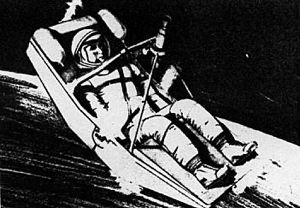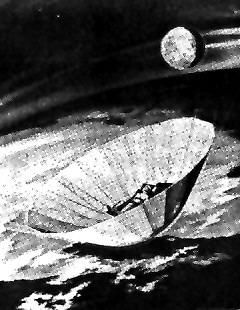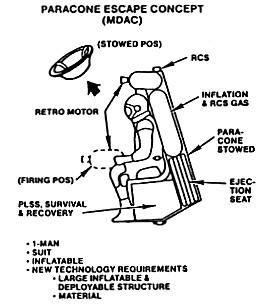
Home - Search - Browse - Alphabetic Index: 0- 1- 2- 3- 4- 5- 6- 7- 8- 9
A- B- C- D- E- F- G- H- I- J- K- L- M- N- O- P- Q- R- S- T- U- V- W- X- Y- Z
Paracone
 Paracone Retrofire Douglas Paracone personal orbital escape system of the 1960's |
Status: Study 1963. Payload: 89 kg (196 lb). Thrust: 431 N (96 lbf). Gross mass: 227 kg (500 lb). Unfuelled mass: 216 kg (476 lb). Specific impulse: 255 s. Height: 1.00 m (3.20 ft). Span: 7.62 m (24.99 ft).
After separation from the spacecraft, the undeployed Paracone consisted of essentially the pilot in his seat, with a small solid retrorocket motor mounted on struts above the pilot's chest.
The astronaut would first roughly orient himself and the seat facing forward along the direction of orbital motion using cold gas thrusters. Then he would ignite the solid rocket motor. The motor had 18 seconds of low level 'vernier' thrust (9 kgf), during which time the pilot could correct its alignment using hand holds on the motor. It then went into 60 seconds of full thrust (44 kgf). The Paracone was designed to handle re-entry angles resulting from up to 30 degrees misalignment of the motor. Accuracy was within 800 km of the planned impact point.
After retrofire the empty motor was discarded and a large light-weight re-entry shell was deployed from the seat by gas pressure. The same gas supply was used for the reaction control thrusters. With a low ballistic coefficient the Paracone could be made of Rene-41 alloy fabric, with a Teflon coating. Heat loads were calculated to be within the heat rejection capacity of the astronaut's portable life support system. A ballistic re-entry followed, with a peak of 9.6 G's. No parachute was required. The terminal velocity of the Paracone was 42 km/hour and impact was absorbed by the crushable structure of the cap of the cone. The total mass of the Paracone system compared favorably with that of conventional ejection seats.
The mass breakdown was:
- Astronaut & Suit: 88.9 kg
- Seat & Restraints: 13.6 kg
- Survival Pack: 10.9 kg
- Life Support Pack: 13.6 kg
- Re-Entry Vehicle Structure: 56.7 kg
- Pressurization System: 6.8 kg
- Control System: 2.3 kg
- Retro Motor: 17.7 kg
- Retro Motor Mounts: 2.7 kg
- Ejection Motors: 4.5 kg
- Beacons: 5.0 kg
- Packaging Structure: 4.5 kg
- Total: 227.2 kg
Family: Space station orbit. Country: USA. Propellants: Solid. Agency: Douglas. Bibliography: 421.
 | Paracone Re-entry Douglas Paracone with the heat shield deployed |
 | Douglas Bailout Douglas Bailout System Cutaway |
 | Paracone |
1963 October 9 - .
- Douglas Paracone "flying carpet" escape system from orbital space stations. - .
Nation: USA.
Spacecraft Bus: Rescue.
Spacecraft: Paracone.
A 'flying carpet' escape system from orbital space stations had been proposed by Douglas Aircraft Company. The escape system would be a saucer shape that would expand into a blunt-nosed, cone- shaped vehicle 7.6 m across at its base. The vehicle would act as its own brake as it passed through the atmosphere. Reentry heating problems would be met by using fabrics woven with filaments of nickel-based alloys.
Back to top of page
Home - Search - Browse - Alphabetic Index: 0- 1- 2- 3- 4- 5- 6- 7- 8- 9
A- B- C- D- E- F- G- H- I- J- K- L- M- N- O- P- Q- R- S- T- U- V- W- X- Y- Z
© 1997-2019 Mark Wade - Contact
© / Conditions for Use